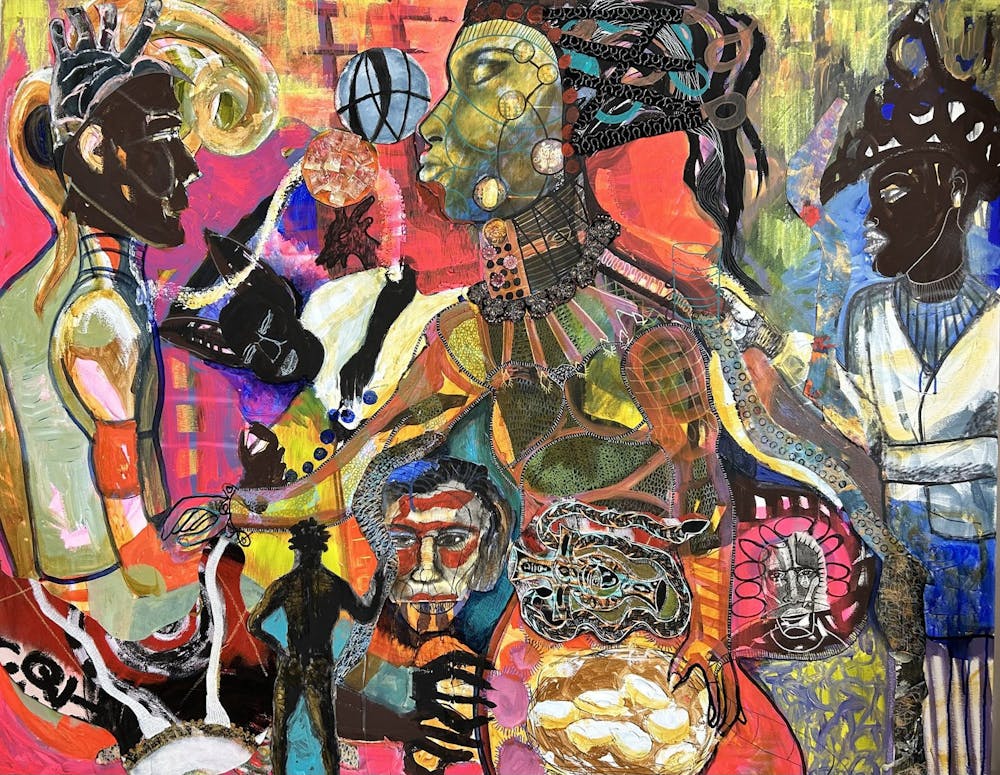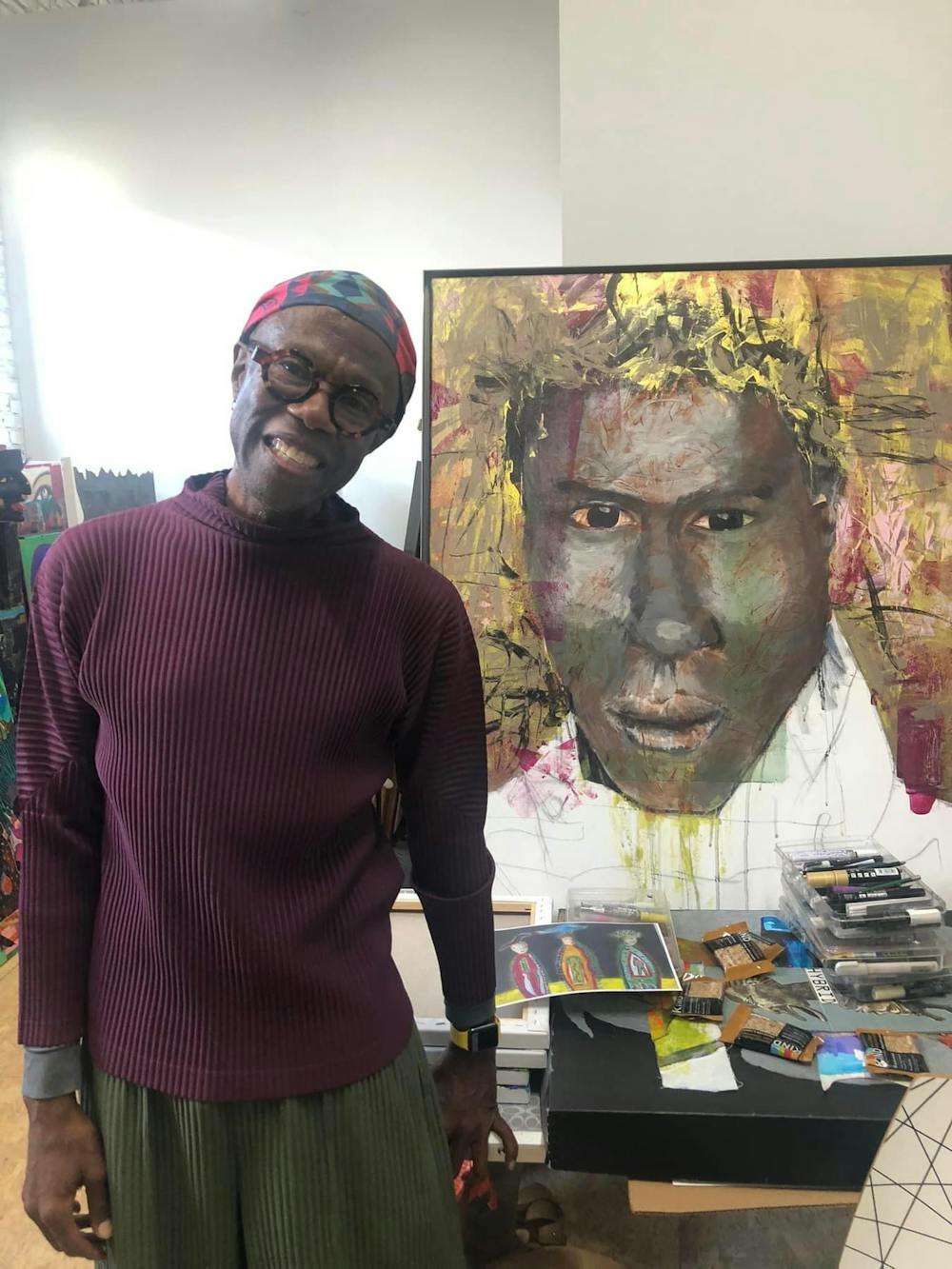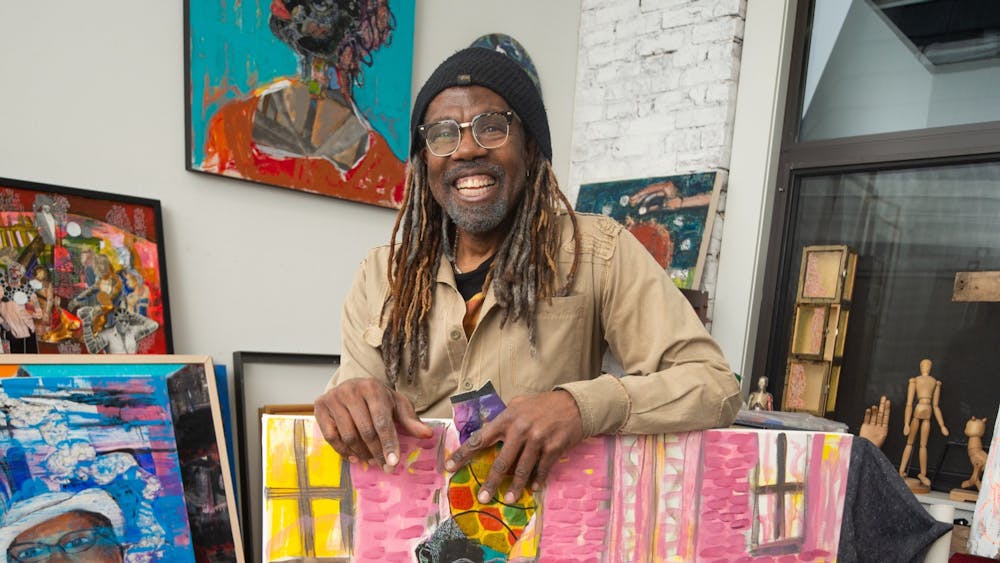For Mikel Elam, the canvas is a portal.
Sitting in his studio surrounded by stacks of brightly colored paintings filling the entire length of his wall, the Philadelphia native and Afro–futurist visual artist clearly remembers his first encounter with art in third grade. Art arrived at a pivotal time for him, shortly after his father passed away. “I dived into art, and I dived into reading,” says Elam, “I'm pretty sure that that was escapism from what had suddenly changed.” The canvas became Elam’s means of seeking out another world, one that transcends the bounds of reality.
From his studio in North Philadelphia, Elam works to reimagine our collective future, brushstroke by brushstroke. He smiles wide as he shares his hopes of a utopian world beyond the confines of inequalities, embodying a grounded optimism that cuts through the cynicism of modern life. In many ways, he redefines the artist as a philosopher, bringing forth ideas of universalism, multiculturalism, and progress through his paintings.
From the moment Elam began creating, art colored the way he moved through life. “I chose [art] because there was nothing else. I thought about it all the time. It was in every reference. If I wrote, it was probably something that dealt with other artists. I was just so impassioned by it. There was no way that I could ignore it,” says Elam. “They were like you’re going to be a poor artist and I can’t say that didn’t happen. It did happen. But on the other hand, still, there was no fear there. I think that is why I chose [art]. There was no fear. I had no fear that I would fail.”
After experimenting with various forms and mediums, his current artistic period consists of abstract hybrid paintings in the vein of Afro–futurism, a utopian philosophy rooted in the equality and liberation of Black folks and other marginalized cultures. Afro–futurists, like Elam, work at the intersection of past, present, and future, often interpolating indigenous African art with futuristic images of space to transport the viewer to another universe.

Mikel Elam, Nocturnal Conversations, 2023, mixed media on canvas, 48” x 60”
While much of his early work aesthetically contends with the future and legacy of the African diaspora through the hybridization of multiple forms and aesthetics, Elam didn’t turn to Afro–futurism as a philosophy until the wake of the pandemic and Black Lives Matter Movement. “At first I was just kind of angry and saddened by the society that we lived in. I'm pretty much taking it all in and I had all this time alone, and I wanted to work it out. The way I work it out is through the paintings,” says Elam “I wanted to find a space where I could be happy.” An avid reader since his youth, Elam began devouring books on Afro–futurism, discovering in the process that unknowingly these ideas had been present throughout much of his 40–year–long artistic career.
Many of the ideas that influenced Elam in his youth, such as those of James Baldwin and Zora Neale Hurston, could be connected in the Afro–futuristic tradition. As it happened, while a teenager, Elam had even seen avant–garde jazz musician and iconic Afro–futurist Sun Ra in concert at a Philadelphia park, unaware of his utopian politics. In fact, Sun Ra happened to reside only a few minutes away from Elam’s Germantown art studio. “The idea has always been there,” says Elam, reflecting on the collective legacy from which he draws, “Anything I’m doing, parts of it have been done before. Any music we’ve heard, parts of it have probably been used before. But what’s different is how you and I would interpret it. So you’re going to make [art] based on being a 2023 dweller in this reality.”
Jazz has played an influential role in Elam’s work. In many ways it seems to represent the utopias that Elam paints as a forward–looking artistry built from the amalgamation of cultures. In jazz, Elam points out, there’s no wrong note as long as you know what to do with it. In his artwork, “There’s no bad brush stroke as long as you know what to do next.” He nods his head to an imagined song as he lists off the artists he’s been listening to when he paints: Sonny Rollins, Wayne Shorter, Philadelphia native Ursula Rucker. All of them, he notes, have some connection with this universal ideal of Afro-futurism, even if they weren’t explicitly identified with the theory. Elam smiles as he adds one last artist to his current playlist: Miles Davis, of course.
Elam first met Miles Davis in his early 20s while living in New York. Davis, often associated with his career as a brilliant trumpeter, also had a career as a prolific visual artist in his late life. A friend recommended Elam as a painter’s assistant for Davis. Young, jobless, and full of artistic spirit, the job came at a transformative time for Elam. He met Davis the day of his interview, and the musician showed him a few sketches. The two clicked immediately and soon began a half–a–decade–long friendship that lasted until the Davis’s death in 1991. Elam laughs, though, recounting Davis’s initial sketches “I’ll be honest, I had no idea what I was looking at.”

Photo Courtesy of Mikel Elam
Elam took his assistantship position assuming that he would teach Davis the tenets of painting that he had picked up in art school. But in fact, the opportunity served as a re-education for Elam, his artistic perspective entirely transformed under Davis’s tutelage.
“He liked young people, and he brought a lot of young musicians in because he liked their new ideas, but I was totally green with so many things and he showed me how to look at things differently,” says Elam. “Little by little, I started to realize that I just came out of a formula situation, where everything was, ‘this is good’, and 'this is bad'. It’s very rigid. You don't come into your own until you start to realize that’s a formula that doesn't even work all the time.”
Elam stood by Davis’s side as he toured the world. Slowly, he began to discard the concept of perfectionism to uncover his own experimental expression. “We're not perfect, but we find like this perfect way to work with imperfect ideas.” His artistic process in a way mirrors optimistic dreams of Afro–futurism; nothing is irredeemable, but simply in progress—whether it’s a fractured society en route to a multicultural utopia or a misplaced brushstroke on its way to a masterpiece.
Elam now works in an airy studio nestled at the top of the stairs in Firehouse Arts. This Sunday happens to be an open–studio event at Firehouse Arts. People chat in the colorful corridors and visit the various studios housed at the collective. Atop Elam’s desk sits a large portrait that greets studio visitors with a powerful gaze. It’s impossible to pin down who exactly Elam has painted: this man could be the king of an ancient African kingdom just as well as he could be king of a future civilization; perhaps, this could be a portrait of a man from the corner transported to an alternate universe.

Photo courtesy of Mikel Elam
This ambiguity is intentional. The hope is that any person stepping up to an Elam canvas has the opportunity to envision their own utopia based on their personal hopes and dreams. “The viewer can bring whatever idea they want to the painting because there's so much to look at, but at the end of the day, you'll feel like you're looking into another world,” says Elam, grabbing a granola bar from within the mix of brushes, oil, paints and snacks on his desk. “Art is public. Art is for everybody. I might make it and sign my name and say that it was mine, but I’m really releasing it to the world.”
Elam’s work is currently on display at The Arts Lounge of the Annenberg Center for the Performing Arts in an exhibition, entitled “Bliss Consciousness”. Funded by the Sachs Program for Arts Innovation, the collection was curated by the Past Present Project. The work plays on the themes of evolution and self–growth, asking us to imagine the history we carry with ourselves and the people we have yet to become. In his work, art and spirituality coexist. “It’s about ascension. It’s about rising. It’s not something that you can necessarily see arising, but you might feel arising.” While the painting might be frozen on the canvas, the feelings it’s intended to elicit are dynamic and fluid.
Sitting in his studio, Elam is at home in this utopian universe he’s brought alive through his canvas. This world of his imagination reaches beyond his studio, beyond even Elam’s paintings, living inside each audience inspired to imagine a better future. He notes that as an artist, it’s never about any single painting. Instead, it’s the body of work as a whole that speaks. Elam offers a translation for the dozens of paintings stacked around him. “They say I existed, and this is what I believe in,” he says, “They say, it’s all about love and compassion.

